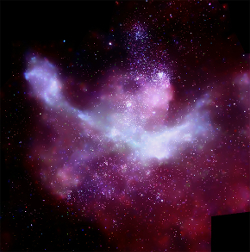 HEAPOW: Is a Star Born? (2019 Feb 25)
HEAPOW: Is a Star Born? (2019 Feb 25)
There are a number of important star factories in our Milky Way Galaxy. One of the most important and interesting is the Great Nebula in Carina, an enormous cloud of gas and dust which lies in the Milky Way's Sagittarius-Carina spiral arm. The Carina Nebula is home to a wide variety of stars, from small, low-mass stars to some of the most massive stars in the Milky Way (including the mysterious, explosive Eta Carinae). X-ray observations play an important role in understanding star formation in places like the Carina Nebula. Stars form inside the densest parts of these thick interstellar clouds. High-energy X-ray emission from young, active stars can penetrate immense amounts of obscuration, allowing us to obtain a unique view of the population of newborn stars. X-ray studies of star forming regions give us an understanding of the demographic distribution of new stars, showing us where most stars in the Nebula form, and giving us some understanding of how many newborns are skinny, low-mass stars and how many are big, fat and massive. X-ray emission can help us understand which stars have gravitationally-bound siblings, and which are solitary. X-ray observations also help us understand the history of stellar birth and stellar death, and the complex effects that the deaths of earlier generations of stars can have on the types of stars we see forming today. The image above is the deepest, clearest, full-color X-ray image of the Carina Nebula we've ever obtained. It was obtained from 15 days of observations with the Chandra X-ray Observatory from 2004 to 2008. The colors displayed represent the observed energy of the X-ray emission: red represents low-energy X-ray emission from cooler, unobscured material, while green and blue are higher-energy X-rays from hotter, more obscured stars and hot gas. This image reveals more than 14,000 young stars forming out of the raw material in the Nebula. The Chandra image also reveals X-ray emission from up to six neutron stars, marking the compact leftover cores of massive stars that died and exploded as supernovae. The image also shows a diffuse X-ray glow permeating the Nebula, produced by a combination of strong stellar winds and supernovae.
CXC: Carina Nebula: Nearby Supernova Factory Ramps Up
viewtopic.php?t=23674
| << Previous HEAPOW | High Energy Astrophysics Picture of the Week | Next HEAPOW >> |
